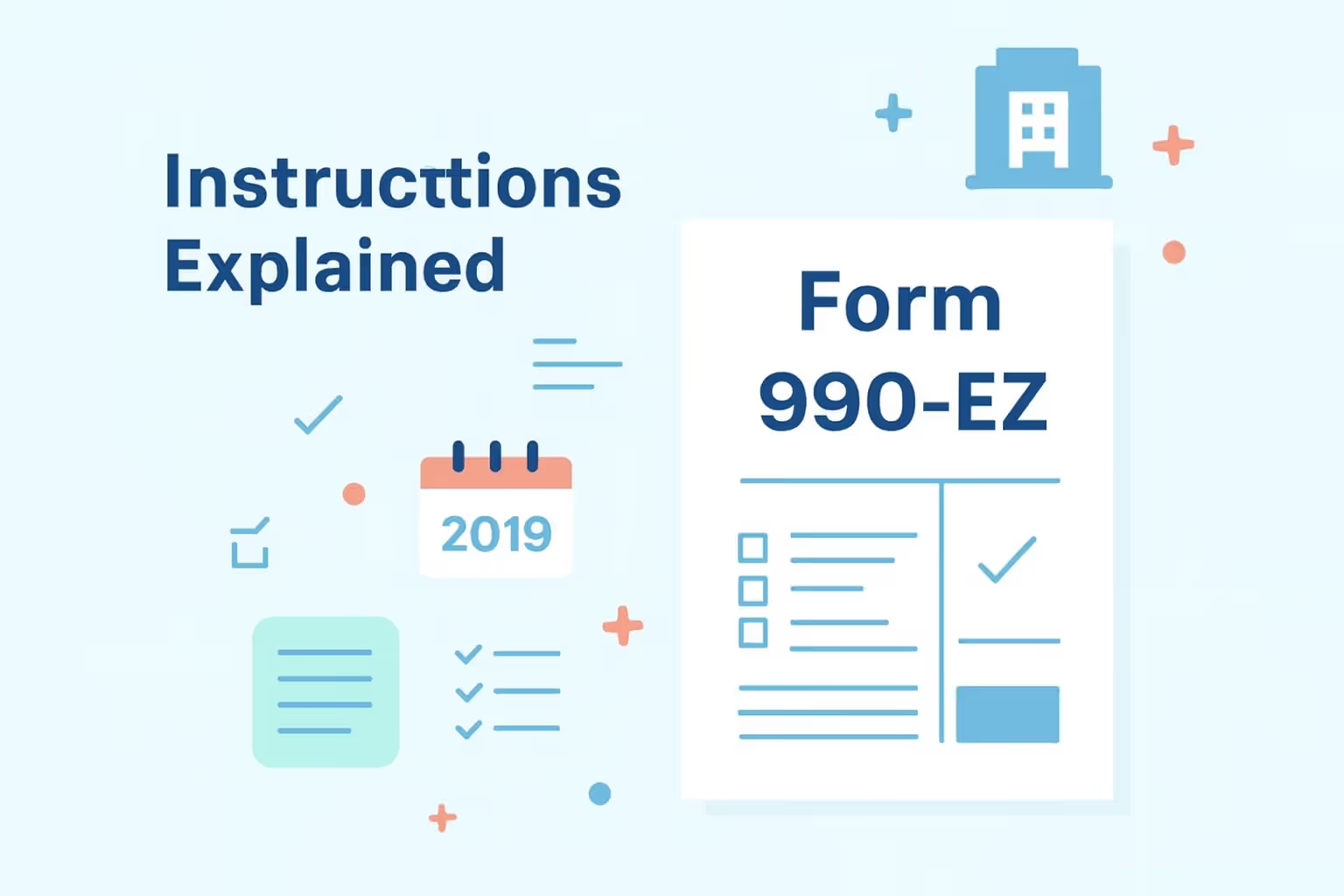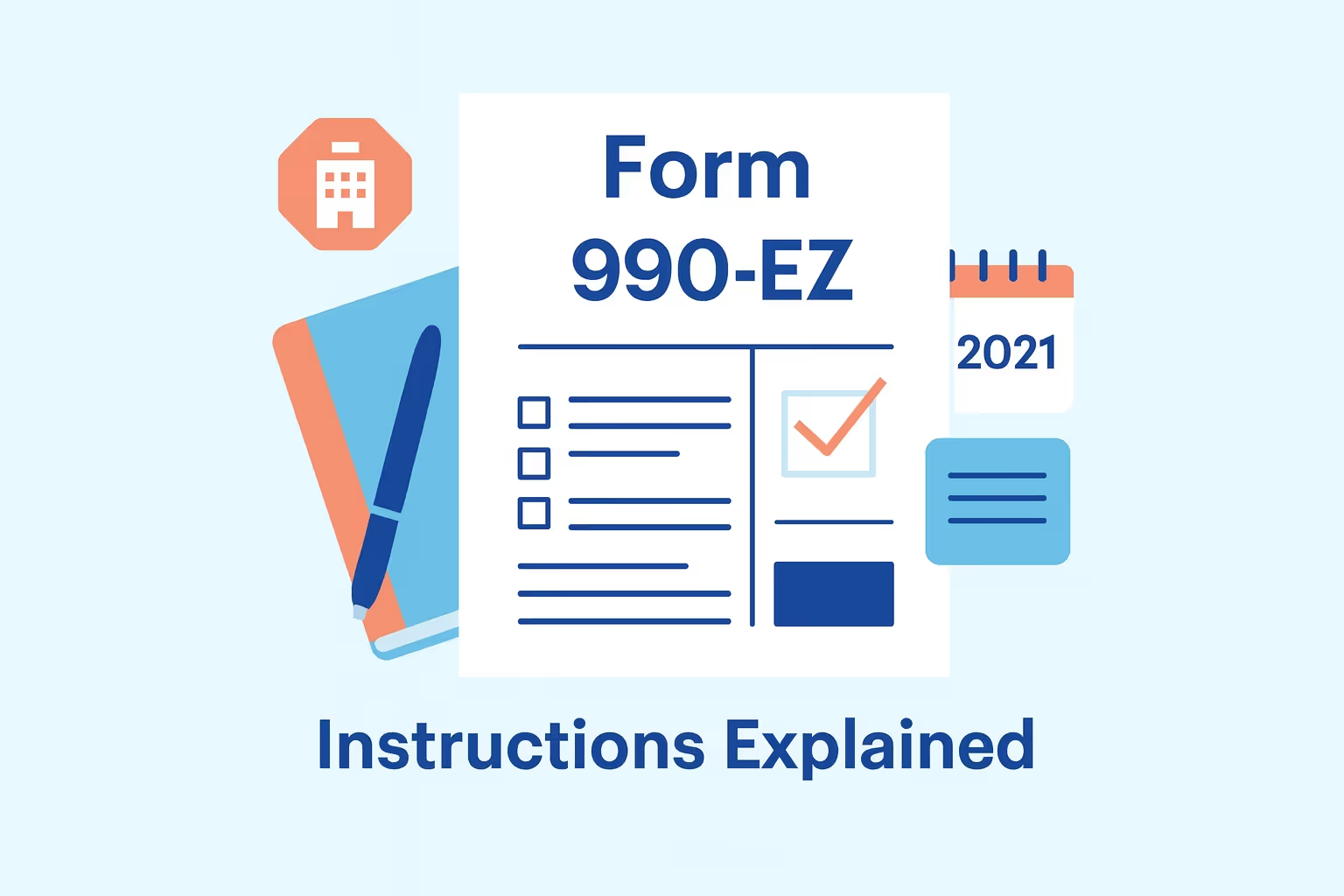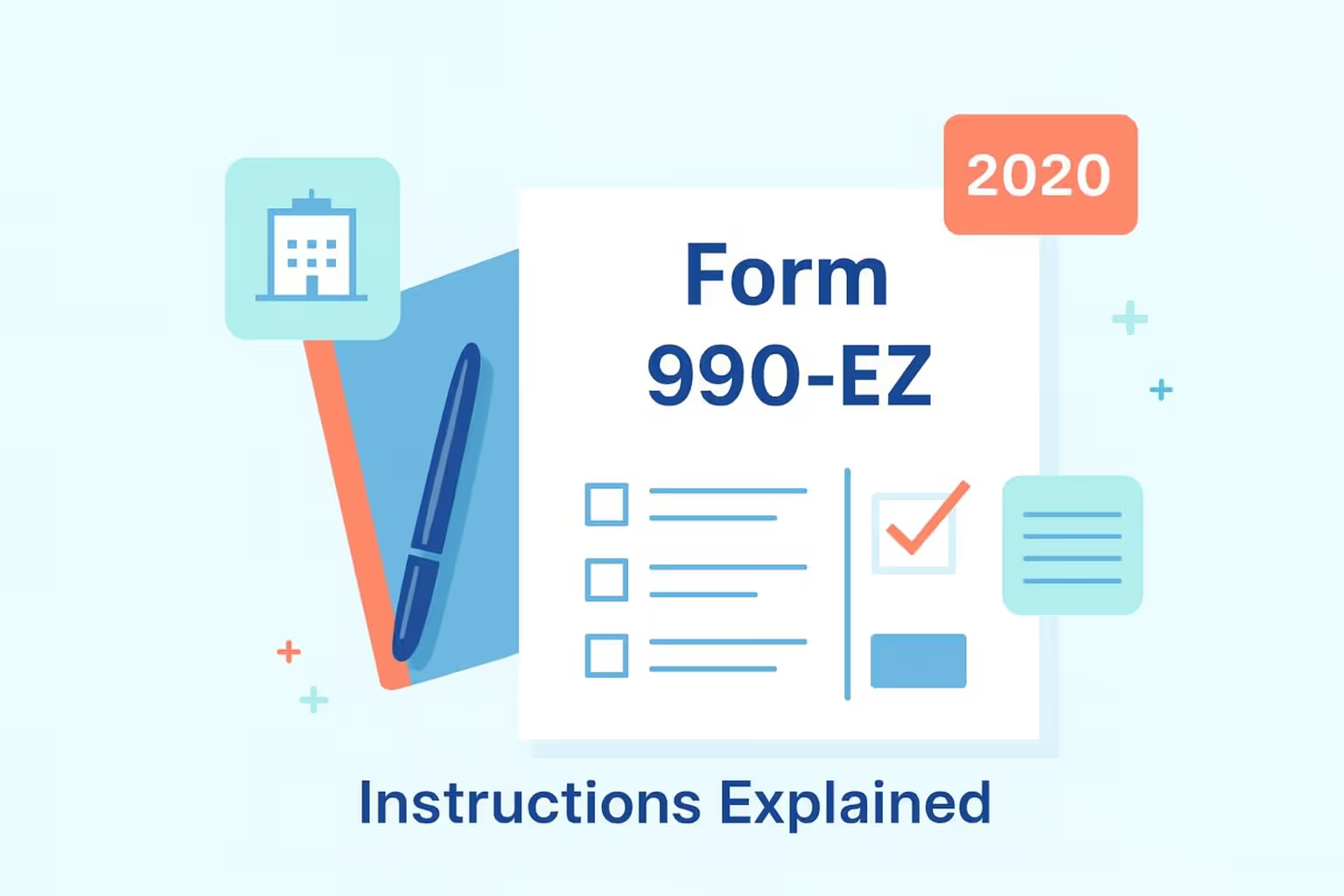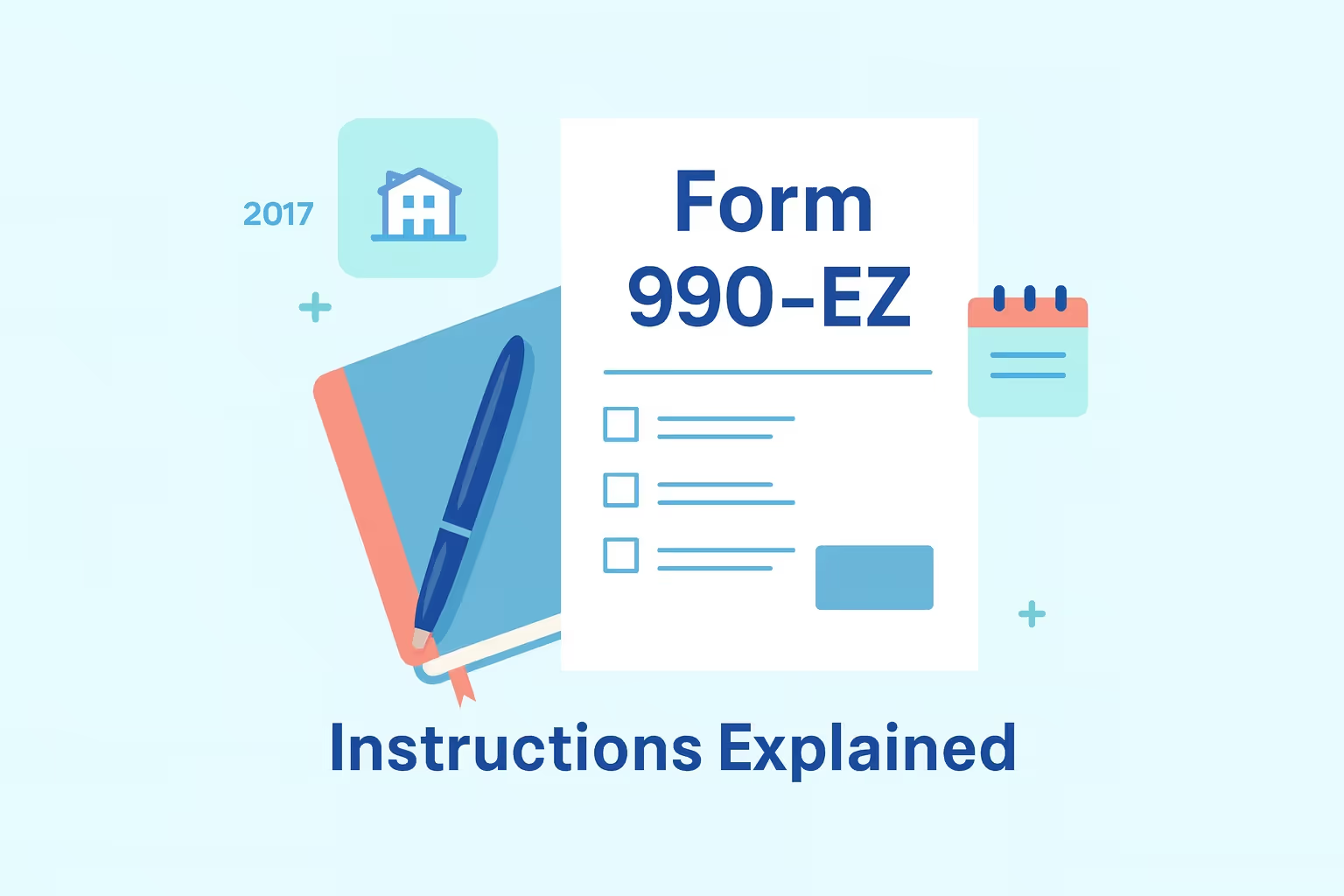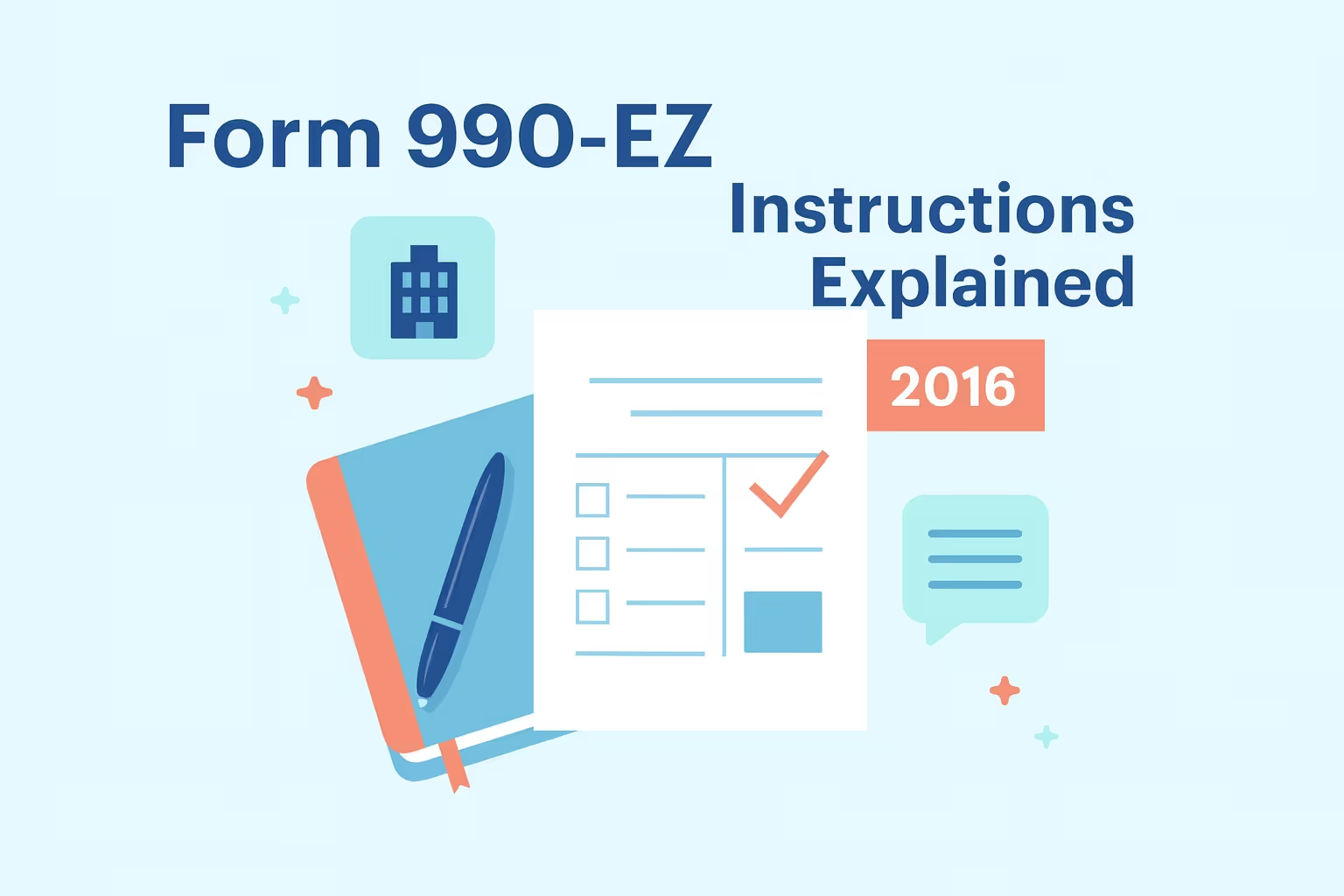Form 990-EZ 2011 Instructions for Tax-Exempt Organizations
Filing accurate annual returns is a crucial responsibility for nonprofit organizations seeking to maintain their federal tax exemption under the Internal Revenue Service (IRS). Form 990-EZ, also known as the Short Form Return of Organization Exempt From Income Tax, enables smaller tax-exempt entities to report their operations and financial activities to the government. For Tax Year 2011, eligible organizations that operated exclusively for charitable, educational, or religious purposes used this form to comply with filing requirements and preserve their exempt status.
The 2011 filing guidelines remain valuable for organizations amending a prior return or verifying information from earlier tax years. Understanding eligibility ensures that qualified nonprofits with gross receipts under $200,000 and total assets below $500,000 can use Form 990-EZ correctly. Proper filing also maintains transparency with the general public, helps donors confirm the organization’s standing, and demonstrates compliance with the Internal Revenue Code Section 501(c).
According to the IRS, the 2011 Form 990-EZ Instructions explain the reporting process, required data, and filing conditions for small organizations. This guide walks you through determining qualification, identifying your entity type, and completing each part of the form accurately for federal income tax purposes.
Understanding Tax Exemption and Eligibility
Nonprofit organizations that operate exclusively for charitable, educational, or religious purposes may qualify for tax exemption under the Internal Revenue Code Section 501(c). To earn recognition from the Internal Revenue Service, each entity must show that its structure and activities serve the public interest rather than private benefit. Meeting these standards allows organizations to avoid federal income tax and build trust through transparent operations and accurate annual filings.
Qualifying for this status requires passing both organizational and operational tests. The entity must be established as a corporation, trust, or association with a mission centered on community welfare, education, or religion. Its governing documents must confine activities to approved purposes and include a clause directing that any remaining assets be transferred to another exempt entity upon dissolution.
Organizations that engage in unrelated business activity or distribute profits to individuals typically lose eligibility. Leaders must ensure that revenue supports the organization’s mission and does not benefit private interests. Political campaigning or funding efforts to influence legislation can also jeopardize tax exemption.
To determine whether Form 990-EZ applies, organizations must review their financial position and structure. Entities with annual gross receipts of $200,000 or less and total assets of $500,000 or less can usually file the simplified return. Groups exceeding these limits must file Form 990, while those with gross receipts of $50,000 or less may file Form 990-N.
- Gross Receipts Threshold: Organizations must have annual receipts of $200,000 or less to file Form 990-EZ.
- Asset Limitation: Total assets must remain under $500,000 at the end of the fiscal year.
- Exempt Purpose: The entity must operate exclusively for charitable, religious, educational, scientific, or similar causes.
- Organizational Test: Articles of incorporation must outline an approved exempt mission.
- Operational Test: Day-to-day activities must support the organization’s exempt purpose.
- Public Accountability: Records should confirm that revenue supports the organization’s mission and benefits the community.
- Prohibited Activities: Engaging in political campaigns or using funds to influence legislation can jeopardize the exemption.
These standards guide organizations in verifying their eligibility for tax exemption. The IRS Publication 557: Tax-Exempt Status for Your Organization outlines how entities qualify for recognition as tax-exempt organizations. It also provides guidance on maintaining compliance, governing responsibly, and demonstrating alignment with federal standards. This publication is a key reference for understanding ongoing filing obligations.
Maintaining compliance confirms eligibility and strengthens accountability with donors, regulators, and the general public. After verifying qualification, each organization should determine which 501(c) classification best reflects its mission and operations. Choosing the proper classification ensures accurate reporting and lasting IRS recognition.
Types of 501(c) Organizations
Nonprofit organizations are classified under Internal Revenue Code Section 501(c) according to their structure, mission, and activities. Each category determines how the entity qualifies for tax exemption, manages revenue, and reports annual returns to the Internal Revenue Service. Understanding the distinctions ensures that every filer accurately represents its operations and meets federal compliance requirements.
Entities seeking tax-exempt status must demonstrate that their purpose aligns with community benefit, general welfare, or public service. The classification also determines whether contributions qualify as tax-deductible under federal income tax law. Leaders should carefully review their organization’s mission, membership requirements, and funding sources before determining the appropriate category. Accurate classification helps maintain good standing and transparency with donors and the general public.
Major 501(c) Classifications
- 501(c)(3) Public Charities and Private Foundations: These organizations operate exclusively for charitable, educational, religious, or scientific purposes. Contributions are tax-deductible, and activities must serve the public interest. Private foundations follow additional reporting rules and may provide grants or financial assistance to eligible entities.
- 501(c)(4) Social Welfare Organizations: These groups focus on advancing civic betterment and promoting the common good. They may support legislation that benefits the community, but cannot engage in political campaigns. Donations are generally not tax-deductible for federal income tax purposes.
- 501(c)(5) Labor and Agricultural Organizations: These entities represent employees, farmers, and similar workers. They advocate for better working conditions, fair wages, and improved industry standards. Membership dues often support operational expenses and educational programs.
- 501(c)(6) Business Leagues: These associations promote the interests of members involved in commerce, trade, or professional fields. Activities must aim to improve business conditions rather than generate profit. Dues and fees must directly support the organization’s activities and mission.
- 501(c)(7) Social and Recreational Clubs: These organizations provide leisure, fellowship, and recreational opportunities for members. They must primarily serve members rather than the general public and may generate limited income from non-member activities.
Each classification includes specific compliance expectations, reporting standards, and operational restrictions. Before filing annual returns, leaders should confirm the organization’s classification to ensure alignment with IRS requirements. Correct classification supports transparency, reinforces public trust, and safeguards the organization’s federal tax exemption.
Step-by-Step Guide to Completing Form 990-EZ 2011
Completing Form 990-EZ accurately helps nonprofit organizations maintain their federal tax exemption and remain transparent with the Internal Revenue Service. The process involves gathering key financial data, verifying leadership information, and reporting the organization’s activities for the year. Each part of the form focuses on different areas of compliance, ensuring that every tax-exempt entity provides a complete picture of its operations and financial position.
The following steps outline how to prepare and complete the 2011 version of Form 990-EZ. Careful review of each section helps eligible organizations meet federal filing requirements and demonstrate accountability to donors, regulators, and the public.
Step 1: Gather Required Information
Begin preparation by collecting essential documents and financial statements. This includes income records, expense summaries, balance sheet details, and bank account statements. Verify the organization’s Employer Identification Number, official name, and mailing address to ensure consistency with Internal Revenue Service records.
Step 2: Complete the Heading
Enter the correct tax year dates, ensuring that the start and end dates match the fiscal year used for accounting purposes. Record the organization’s full legal name and address exactly as recognized on the IRS determination letter. Confirm the website address, Employer Identification Number, and applicable tax year box before continuing.
Step 3: Report Financial Data in Part I
Part I requires reporting all sources of revenue and expenses. Include membership dues, grants, and tax-deductible charitable contributions that fund the organization’s exempt purpose. Record total program service revenue, investment income, and other funding streams, ensuring accuracy across each category.
Step 4: Prepare the Balance Sheet in Part II
List all assets, including cash, savings, investments, land, and equipment. Record liabilities such as loans or outstanding obligations. Calculate total net assets to confirm that the organization’s financial position aligns with previous filings and bank statements.
Step 5: Describe Program Service Accomplishments in Part III
Summarize the organization’s mission-driven achievements during the tax year. Provide precise data showing the number of individuals served, programs completed, and grants awarded. Use concise language to show how expenditures advanced the organization’s programs and community objectives.
Step 6: Report Leadership and Compensation in Part IV
Disclose all officers, directors, trustees, and key employees. Include titles, average weekly hours worked, and total compensation. Ensure amounts align with payroll or contractor records and document any additional financial assistance or benefits provided.
Step 7: Complete Other Information in Part V
Answer all operational questions honestly and thoroughly. Indicate whether the organization engaged in political campaigns, foreign transactions, or related-party activities. Accurate responses verify compliance with federal income tax requirements and maintain public confidence.
Step 8: Address 501(c)(3)-Specific Questions in Part VI
Organizations classified under Section 501(c)(3) must confirm governance, public disclosure practices, and grantmaking procedures. Provide information about policies covering conflicts of interest, whistleblower protection, and document retention. These disclosures reinforce the entity’s commitment to ethical and accountable management.
Completing each step carefully ensures that the filing reflects accurate data and supports the organization’s mission. Once each section is verified, leadership should review all entries for consistency and completeness before submission. Careful preparation reduces the likelihood of delays, correspondence, or rejections during processing.
Reporting Charitable Contributions and Revenue
Nonprofit organizations must clearly identify their revenue sources to meet Internal Revenue Service requirements and maintain their tax-exempt status. Precise reporting ensures transparency for donors, demonstrates responsible stewardship, and aligns with federal income tax requirements. Each entry on Form 990-EZ must reflect how the organization’s activities advance its mission and serve the community.
Organizations that receive donations, grants, or membership dues must distinguish between each type of funding. Precise categorization supports proper financial reporting and confirms whether contributions qualify as tax-deductible charitable contributions. Leaders should maintain records that document donor intent, payment methods, and valuation of non-cash gifts to substantiate every figure reported.
Correctly classifying income also allows the organization to evaluate its funding diversity and long-term sustainability. Revenue from mission-related programs, investments, or special events must be reported separately. Each amount should align with supporting schedules, ensuring accuracy across the complete form.
- Line 1 – Contributions, Gifts, and Grants: Record all donations, foundation grants, and public gifts that directly support the organization’s mission. These amounts represent funds voluntarily given without receiving goods or services in return.
- Line 2 – Program Service Revenue: Include income earned from activities that further exempt purposes, such as tuition for educational programs or fees for community services.
- Line 3 – Membership Dues and Assessments: Report payments that provide members with specific privileges or access to benefits while supporting the organization’s operations.
- Line 4 – Investment Income: Enter earnings from interest, dividends, or investment gains that supplement general funding.
- Line 5 – Sale of Assets or Inventory: Reflect gains or losses from selling property, merchandise, or other assets used in operations.
- Line 6 – Fundraising and Gaming Activities: Record gross income from events, raffles, or games of chance, netting costs where applicable.
- Line 7 – Other Revenue: Capture any remaining sources not covered above, including rental income or royalties linked to charitable efforts.
Each revenue category clarifies how the organization generates funding and sustains community programs. Maintaining detailed documentation verifies compliance with federal requirements and strengthens donor confidence. Consistent reporting across tax years also enables leaders to evaluate growth, plan budgets, and align resources with their long-term goals.
Annual Returns and Filing Deadlines
Every tax-exempt organization must file timely annual returns to remain compliant with the Internal Revenue Service. Meeting these requirements supports continued recognition under the Internal Revenue Code and reinforces financial accountability. Accurate and punctual submissions also help the organization maintain credibility with donors, the general public, and government agencies.
Entities filing Form 990-EZ must determine their accounting period and review all reporting obligations early in the process to ensure compliance with the requirements. A clear filing schedule provides sufficient time to prepare accurate data and supporting documentation. Leadership teams should verify all details before submission to prevent errors or correspondence from the IRS.
- Determine the Tax Year: Identify whether the organization operates on a calendar year, ending December 31, or a fiscal year, which concludes on a different date. The selected period establishes the deadline for filing annual returns.
- Calculate the Due Date: Form 990-EZ is due on the 15th day of the fifth month after the close of the accounting period. Calendar-year filers must submit their returns by May 15 each year.
- Apply the Weekend and Holiday Rule: If the due date falls on a weekend or federal holiday, file on the next business day. Marking deadlines on a compliance calendar helps prevent missed submissions.
- Choose a Filing Method: Eligible nonprofits may e-file for faster processing or mail paper returns using certified mail. Electronic filing confirms receipt and helps reduce entry errors.
- Review for Completeness: Ensure that all figures, schedules, and required signatures are included. Missing or inaccurate data may cause processing delays or rejection.
- Request an Extension: The Form 8868, Application for Extension of Time to File, explains how organizations can obtain a three-month automatic extension, with an additional three-month extension available upon approval. This option grants more time for reviewing records and finalizing documentation.
- Maintain Proof of Filing: Keep electronic confirmation or mailing receipts with permanent financial records. Retaining evidence of submission supports future audits or compliance reviews.
Following these steps ensures timely filing, protects exempt status, and promotes transparent financial management across all tax years. Consistent adherence to deadlines strengthens organizational reliability and demonstrates strong governance practices.
Common Filing Errors and How to Avoid Them
Accurate reporting on Form 990-EZ is crucial for maintaining tax-exempt status and avoiding compliance issues with the Internal Revenue Service. Many organizations encounter setbacks when key sections are incomplete, schedules are missing, or figures do not match supporting documentation. Understanding common errors helps nonprofit leaders prepare more accurate and reliable filings, thereby preserving public trust.
Frequent Mistakes That Delay Processing
- Returns without signatures are incomplete and cannot be processed, so authorized officers must sign before filing.
- The Employer Identification Number must appear correctly on every page to match IRS records.
- All additions and subtractions across revenue, expenses, and asset totals must be verified to ensure accuracy.
- All required forms and schedules must be attached to prevent correspondence or rejection.
- Figures reported in Parts I and II must align with financial statements and prior-year totals.
- The beginning and ending dates of the return must reflect the organization’s actual accounting period.
- All “Yes” responses and significant changes in revenue or expenses must be explained on Schedule O.
- Transactions involving officers, directors, or key employees must be fully disclosed and reported in accordance with applicable regulations.
- Property and investments must be valued at fair market value using reliable financial records.
- All grants, awards, and scholarships distributed must be clearly reported and documented.
Best Practices to Maintain Accuracy
- Each return should undergo a thorough internal review before submission to confirm completeness.
- Monthly reconciliations should be completed to ensure that bookkeeping remains accurate throughout the year.
- The most recent version of Form 990-EZ and related schedules must always be used.
- All invoices, receipts, and board meeting minutes should be retained to support reported figures.
- Guidance from a tax professional familiar with nonprofit filings can help identify potential issues.
Proactive error prevention ensures a smoother filing experience and demonstrates accountability to the Internal Revenue Service. Careful review before submission supports compliance and protects the organization’s exemption in future tax years. Consistent accuracy across filings also reinforces donor confidence and strengthens long-term governance.
Recordkeeping and State-Level Requirements
Strong recordkeeping practices are essential for maintaining tax exemption and ensuring compliance with both federal and state regulations. Nonprofit organizations must organize their financial and operational documents to support all figures reported on Form 990-EZ. Maintaining accurate and accessible records also reinforces accountability to donors, regulators, and the general public.
Federal Record Retention
At the federal level, organizations must retain copies of filed returns, supporting statements, and substantiating evidence for a minimum of four years. Retaining these records enables organizations to respond promptly to any inquiries or audits from the Internal Revenue Service. Financial records, receipts, invoices, and bank statements should remain organized and stored securely throughout each tax year.
Permanent records, including the IRS determination letter, articles of incorporation, and bylaws, must always be accessible. These documents demonstrate that the organization was formed and operated exclusively for exempt purposes. They also confirm the entity’s structure, governing authority, and compliance with its mission as outlined in the Internal Revenue Code.
Board meeting minutes, grant agreements, and payroll records must also be maintained to verify operational transparency. Each record shows that activities align with the organization’s stated mission and benefit the public. Consistent documentation safeguards eligibility for continued tax exemption.
Organizational Documents
Corporations and religious organizations must maintain all foundational documents to demonstrate that they meet the organizational and operational requirements. Each document should clearly outline the mission, authorized activities, and limitations on political or unrelated business operations. Written conflict-of-interest and whistleblower policies further demonstrate strong internal governance.
Policies outlining financial oversight and reporting structures help establish accountability among directors and officers. Consistent updates to these records ensure alignment with current operations and legal standards. Detailed documentation also supports accurate reporting across annual returns and state filings.
State Compliance
Many states require separate filings or registrations for charitable solicitation and corporate maintenance. Organizations should verify requirements with their state’s department of revenue or attorney general’s office. These filings often include financial statements, governance disclosures, or renewal applications.
Maintaining accurate records supports compliance with local laws and enhances transparency with the community. State filings also protect an organization’s right to operate, solicit contributions, and maintain public trust. Coordination between state and federal reporting ensures consistent, verifiable compliance records.
Strong recordkeeping practices and adherence to state regulations strengthen an organization’s integrity. Consistent documentation supports accountability, simplifies annual filings, and demonstrates an ongoing commitment to lawful and ethical management.
Frequently Asked Questions
What determines whether an organization qualifies for tax-exempt status?
An organization qualifies for tax-exempt status when it operates exclusively for charitable, educational, or religious purposes under the Internal Revenue Code Section 501(c). To qualify, entities must meet both the organizational and operational tests, ensuring that their activities support public benefit rather than private gain. The IRS approves applications that demonstrate clear exempt purposes, sound governance, and accurate recordkeeping. Entities must also file required returns annually to maintain eligibility and transparency.
Can educational organizations and labor organizations use Form 990-EZ?
Educational organizations and labor organizations may file Form 990-EZ if their annual gross receipts are below $200,000 and total assets remain under $500,000. These entities must still meet the organizational and operational standards for exemption. Educational institutions must demonstrate programs that advance learning, while labor organizations must promote the interests of their members. Each group must file the required returns that accurately reflect its revenue, expenditures, and community-focused activities supporting its exempt mission.
How should organizations report political activities or lobbying expenditures?
Organizations engaging in political activities or lobbying must disclose them on Form 990-EZ. Expenditures related to campaign involvement, legislative influence, or candidate endorsements require detailed reporting and disclosure. Excessive lobbying or political campaigning can threaten tax-exempt status if such actions become a substantial part of an organization's operations. Accurate reporting ensures transparency, allowing the Internal Revenue Service to verify that most organizations remain compliant with the limitations governing nonprofit advocacy.
Can organizations with religious beliefs qualify for exemption?
Organizations grounded in religious beliefs can qualify for tax exemption if they operate exclusively for spiritual, charitable, or educational purposes. They must ensure their programs serve the broader community and align with federal definitions of exempt activities. The IRS approves an exemption when an entity demonstrates a formal structure, established doctrine, and consistent operations. Maintaining proper governance records and filing required returns each year reinforces compliance and continued recognition.
Are organizations promoting public safety eligible for exemption?
Entities focused on public safety may obtain an exemption if their mission benefits the general public, such as volunteer fire departments or community emergency services. Their operations must align with charitable objectives and not provide personal benefits to private individuals. Most organizations in this category must maintain transparent financial practices and demonstrate that resources are directed toward improving community well-being. Filing accurate annual returns confirms continued compliance with federal regulations.
Can individuals holding public office participate in management?
Individuals who hold public office may serve as officers or directors if their roles do not create conflicts of interest. Governance policies should outline procedures for addressing potential overlap between public duties and organizational responsibilities. Most states encourage maintaining independence between personal, political, and nonprofit interests. Documenting decisions and disclosing relationships in required returns supports transparency and safeguards the organization’s reputation for ethical leadership.
What filing expectations apply across most states?
Most states require charitable organizations to register before soliciting donations and to renew filings annually. Requirements may include submitting financial statements, proof of federal tax exemption, and copies of recent returns. Organizations must verify deadlines with the relevant state agency to maintain good standing. Coordinating federal and state filings helps nonprofits maintain compliance, protect donor confidence, and ensure continued authorization to conduct fundraising and community outreach programs.
















